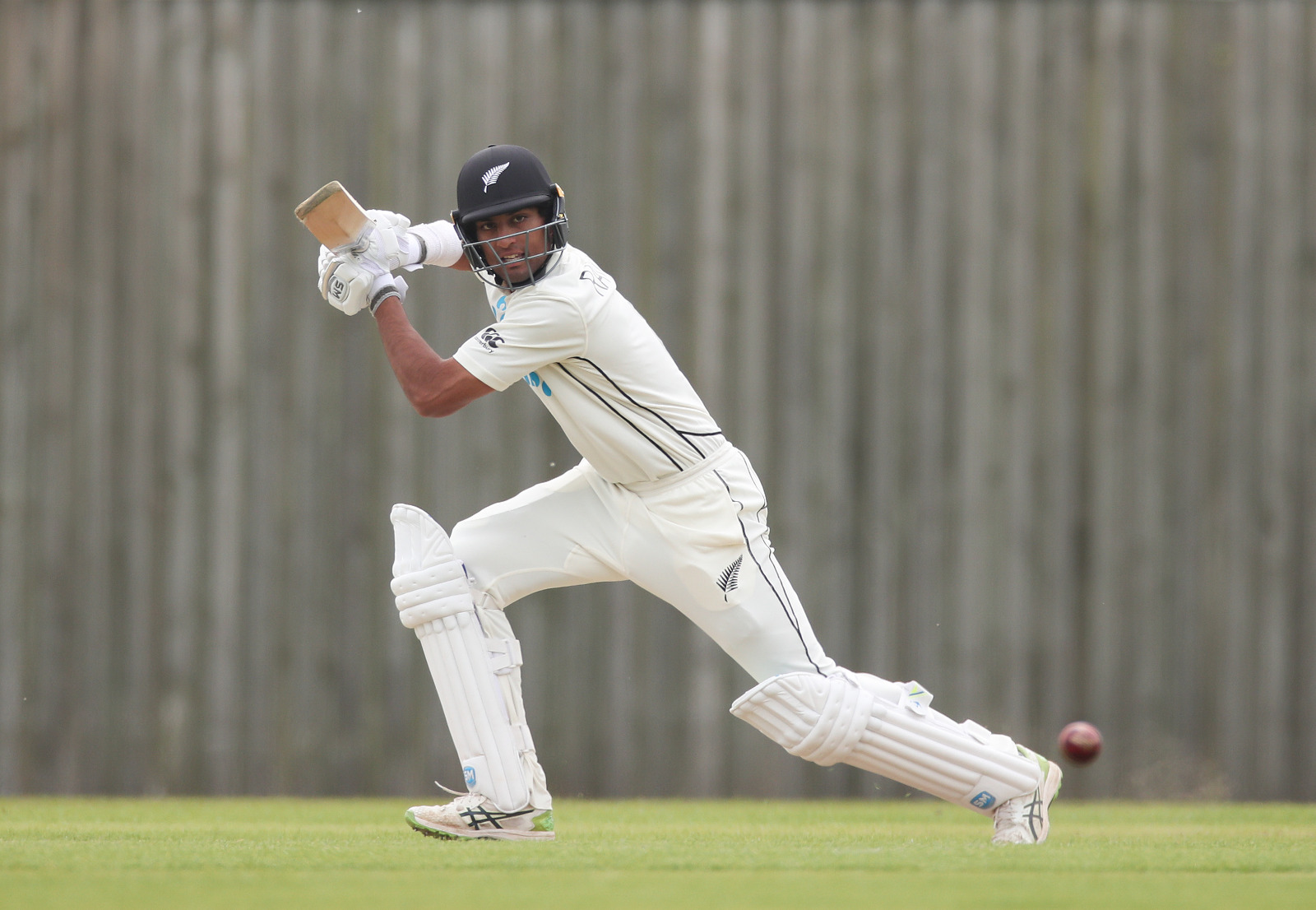‘If Rachin Ravindra grew up in India, he’d have been a genuine all-rounder by now’
Following Rachin Ravindra’s maiden call-up to the national side, SportsCafe caught up with his Wellington Firebirds coach Glenn Pocknall, who gave invaluable insight into the 21-year-old’s development as a cricketer.

“I think his (Rachin Ravindra’s) main strength is his batting. But his bowling is very effective too, he is a left-arm orthodox spinner as well.” These were words uttered two months ahead of the 2018 Under-19 World Cup by former New Zealand bowler Graeme Aldridge, who was the assistant coach of the BlackCaps youth side in the competition. As it turned out, though, Aldridge, rather unintentionally, had ended up severely underestimating the bowling prowess of the youngster.
Ravindra ended the competition with a hundred and a batting average of 38.83, but it was his bowling that catapulted him into the limelight and saw fans term him New Zealand’s very own Jadeja. With 13 wickets in just 6 matches, the young left-arm spinner ended the U19 World Cup as the second-highest wicket-taker and all signs indicated that the Kiwis had discovered a three-dimensional superstar that was destined to torment opponents with both bat and ball for years to come.
But three years on, despite his batting having grown by leaps and bounds, Ravindra’s bowling has stalled. Across three seasons in domestic cricket, the left-arm spinner, across formats, has taken less than 50 wickets and has seen himself largely turn into a specialist opening batsman. Since his debut in red-ball cricket, Ravindra has bowled an average of just 8.23 overs per match while in one-day white-ball cricket, the youngster is no longer the wicket-taker he was in the U19 championships three years ago: 8 wickets is all he’s taken in his career and his bowling average (59.50) fits the description of a part-timer, not a generational all-rounder. He has, in fact, broken his way through into the New Zealand Test set-up via his batting with his bowling, at this very moment, being nothing more than a mere luxury for captains.
So what really has gone wrong in three years? How has Ravindra gone from being the second-highest wicket-taker in a U19 World Cup to someone who, at least in the longest format, is not guaranteed to be summoned to bowl unless the situation demands? Is it a case of him giving up one skill to concentrate on the other or is it simply that his ceiling as a bowler is pretty low, with the showing in the U19 WC being an outlier? Neither, according to his Wellington coach Glenn Pocknall.
Pocknall believes that Ravindra simply is a victim of the extremely seam-friendly wickets in New Zealand that give spinners, in particular young spinners, no scope to develop.
“He’s definitely got the ability to be an all-rounder. What he’s missed out is the conditions to be able to suit him to bowl,” Pocknall tells SportsCafe.
“He’s not bowled as many overs as he would have liked. I think if he was a young spinner growing up in India, he’d be a genuine all-rounder by now just because he’d have been bowling so much. But we play four-day cricket in the early stage of the season and the pitches there aren’t really conducive to spin bowlers bowling multiple spells. That’s hindered his development a little bit.”
The observation from Pocknall is valid. Despite bowling more frequently in white-ball cricket due to being employed as a ‘container’, Ravindra, in the longest format, has been nothing more than a part-timer. 121 overs is all he’s bowled across the last two Plunket Shield seasons, and this season Peter Younghusband is the only Wellington bowler to have bowled fewer overs than Ravindra, among those who featured in 5 or more matches.
But, according to Pocknall, Ravindra is not alone when it comes to not getting enough opportunities to bowl. The Wellington head coach believes that it’s a nightmare to be a young spinner in New Zealand for the simple fact that, owing to the seam-friendly wickets on offer, there is no scope for younger spinners to learn on the job and develop.
“It can be very challenging for them. Especially in these conditions where they don’t get the opportunity to bowl much,” Pocknall says.
“It can be very challenging for a young spinner because they’re not given the opportunity to learn and develop their craft sometimes until it's too late.”
The numbers reflect how ludicrously the four-day wickets are tilted in favour of seamers. In the 2020/21 Plunket Shield season, there was only one spinner, Michael Rippon, among the Top 12 wicket-takers, with each of the first six ranks being occupied by seamers. The 2019/20 season was no different, with only one spinner, Auckland’s Louis Delport, finding a place among the Top 10 wicket-takers. England, recently, came under fire for ‘not taking spin seriously’ in the County Championship, but the situation is currently far worse in New Zealand, where there is a paucity of quality young spinners in the longest format.
The situation is not alarming, yet, but Pocknall feels that for the New Zealand players to develop - on both batting and bowling fronts - it is imperative that more spin-friendly wickets are rolled out at the domestic level.
“I think for New Zealand players to be able to develop overall, we need to be producing wickets that spin. And that certainly will help them become better at playing spin and prepare them for the subcontinent.
“Traditionally we play on flat wickets that are greenish and bouncy, but spin is not prevalent. But for us to become really good against spin bowlers, and also for our spinners to become better, we need to expose them to spinning conditions more often than not.”
So with game-time out of the equation, how, then, does a young spinner in the country develop? The only alternative, Pocknall says, is giving them more time at the nets, but he describes it as a scenario that is less-than-ideal.
“The only alternative we have at the moment is to give the spinners as much time in training, and let them learn their craft there, so when they do play at the higher levels, they know how to adjust their line and length based on what the pitch is doing.
“The only substitute we can give them is to bowl a lot in training, but it’s not ideal. Certainly not optimal for them as they’re not learning the trade during matches.”
The advantage Ravindra has, though, is that he is more than just a quality young spinner; he is also an exceptional young batsman. The southpaw, since December 2020, has struck three first-class tons - including two against a strong West Indies ‘A’ attack the featured the likes of Oshane Thomas, Raymond Reifer and Romario Shepherd - and this prodigious form has seen the 21-year-old find his way into the senior men’s squad for the first time.
Pocknall, having been associated with Wellington for nearly two decades, has overseen Ravindra’s development like no other, and the Wellington coach describes his ward as a hard worker who is hell-bent on always being the best version of himself.
“He’s progressed very fast. He’s a sincere young boy and when he first came into the first-class team, he performed straight away because he had such a big workload of training that he could fall back on. He also had a very astute understanding of how to go about batting. To see a young guy like him succeed straight away was not surprising, but quite often we don’t see that here,” Pocknall says.
“It generally takes the younger player 2-3 years to understand the game but with him being such a student of it, he knew how to go about without having even played it. He is developing every year and every game he plays because he just wants to be the best he can be. It’s a great attitude to have, and it’s great to see him be rewarded with an international call-up.”
Throughout his career in red-ball cricket, Ravindra has plied his trade as an opener, but, interestingly, Pocknall believes that the southpaw has all the attributes to be a successful middle-order batsman. Thanks to the presence of Kane Williamson, Tom Latham, Devon Conway and Will Young, New Zealand are currently blessed with a plethora of world-class top-order batsmen, and, according to Pocknall, slotting down the order ‘could be the best thing for Ravindra in the long haul’.
“I think he can bat in the middle order as well. He’s got a really sound technique - great defensive strength and the ability to leave. With those two attributes, you can bat anywhere in the order. He’s certainly achieved a lot as an opener but if he went down the middle order, he will find a different type of a challenge. He would have to wait to bat and things like that. But the ball not moving a lot, and being soft, could be the best thing in the long haul.”
Opener or middle-order bat, evident through his call-up for the national team, Ravindra has already made it as a batsman. But does he still have it in him to, someday, become a world-class all-rounder? Yes, according to his coach. All Ravindra needs to do to crack the bowling code, Pocknall says, is to keep bowling as much as he can.
“The key for him is to take every single opportunity to bowl. But the more he bowls, the more consistent he will become with his action and where he’s delivering the ball. It’ll come, he’s only 22 now. I do see a bright future for him as an all-rounder.“

Comments
Sign up or log in to your account to leave comments and reactions
0 Comments